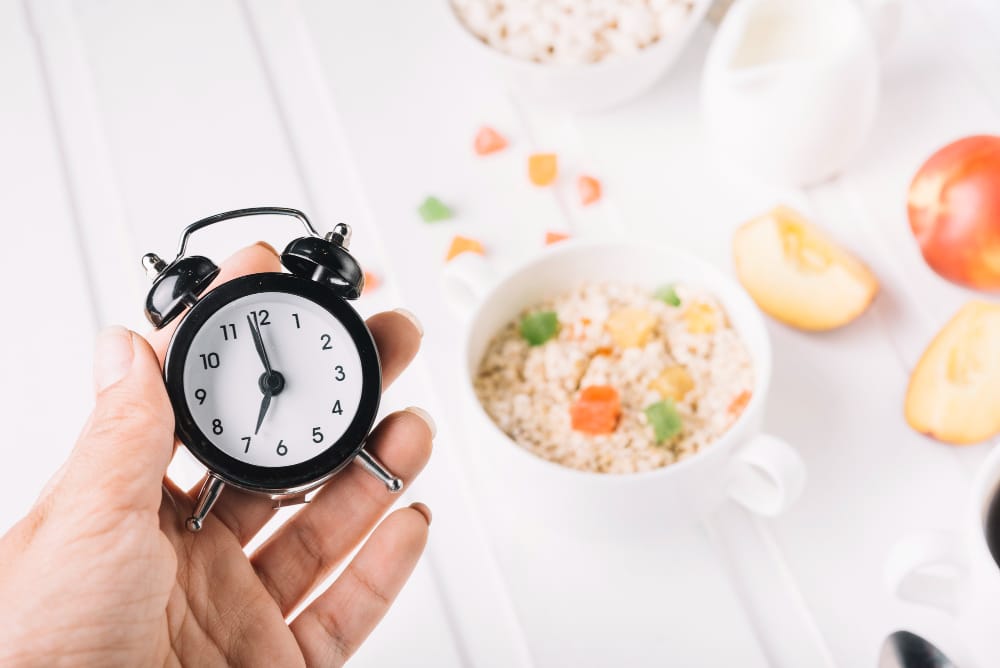Table of Contents
Introduction
In today’s fast-paced world, most people focus on what they eat but rarely think about when they eat. This is where circadian eating comes in — a natural way of eating that aligns your meal timing with your body’s internal clock. Studies suggest that eating in sync with your body’s circadian rhythm can supercharge your metabolism, improve digestion, boost energy levels, and even help with weight management.
In this blog, we will explore the basics of circadian eating, how it affects your metabolism, and practical tips to easily adopt this eating style.
What is Circadian Eating?
Circadian eating is a way of timing your meals to align with your body’s natural 24-hour cycle, known as the circadian rhythm. This internal clock controls various biological functions, including sleep, hormone release, and metabolism.
When you eat according to your circadian rhythm, you work with your body’s natural processes, not against them. This can help your body process food more efficiently and maintain a healthy metabolism.
How Circadian Rhythms Influence Metabolism
The Role of the Circadian Rhythm
The circadian rhythm influences your digestion, insulin sensitivity, and energy production. When you eat at the right times, your body can break down food faster and use nutrients more effectively.
Why Meal Timing Matters
- Morning: Your metabolism is at its highest in the morning. Eating a healthy breakfast can kick-start your body’s fat-burning process.
- Afternoon: Your body is still working efficiently but begins to slow down.
- Evening: Your metabolism naturally decreases in the evening, and eating late at night can lead to weight gain and poor digestion.
Eating in sync with these natural metabolic shifts can help supercharge your metabolism and improve overall health. Check out our blog to learn more: Is Eating Organic Really Healthier?
Benefits of Circadian Eating
Boosts Metabolism
When you follow your body’s natural eating windows, your metabolism works more efficiently, which can help in burning calories effectively.
Supports Weight Management
People who eat according to their circadian rhythm often find it easier to maintain or lose weight because the body uses energy more wisely.
Improves Digestion
Your digestive system functions best during the day and slows down at night. Circadian eating can reduce bloating, indigestion, and acid reflux.
Balances Blood Sugar Levels
Eating at regular, biologically appropriate times can help stabilize blood sugar levels, reducing the risk of type 2 diabetes.
Enhances Sleep Quality
Late-night eating can disturb your sleep cycle. Circadian eating supports better sleep by allowing your body to wind down properly at night.
Best Meal Timing for Circadian Eating

Breakfast: 7:00 AM – 9:00 AM
Start your day with a balanced breakfast that includes proteins, healthy fats, and complex carbohydrates. This is when your metabolism is most active.
Lunch: 12:00 PM – 2:00 PM
Have your largest meal during this window when your digestive system is still working efficiently.
Light Dinner: Before 7:00 PM
Dinner should be the smallest meal of the day. Eating late can confuse your body’s clock and slow down your metabolism.
Fasting Period: After 7:00 PM
Allow your body a fasting period of at least 12-14 hours overnight. This gives your digestive system time to rest and repair.
Practical Tips to Follow Circadian Eating
Tip 1: Set a Consistent Eating Schedule
Try to eat your meals at the same time each day to support your circadian rhythm.
Tip 2: Avoid Late-Night Snacks
Late eating can disrupt your internal clock and make it harder to burn calories efficiently.
Tip 3: Prioritize Daylight Hours
Aim to consume most of your calories when the sun is up. This matches your body’s natural metabolic peak.
Tip 4: Start with Small Changes
You don’t need to overhaul your entire routine. Start by moving your dinner 30 minutes earlier and gradually adjust your eating windows.
Tip 5: Listen to Your Body
Circadian eating is not about strict dieting. It’s about learning to align your meals with your body’s natural rhythms.
Foods That Support Circadian Eating
Breakfast-Friendly Foods
- Oats
- Eggs
- Fresh fruits
- Nuts and seeds
Lunch Power Foods
- Whole grains
- Lean proteins (chicken, fish, tofu)
- Leafy greens
- Legumes
Light Dinner Options
- Soups
- Steamed vegetables
- Grilled fish or tofu
- Small portions of complex carbs like sweet potatoes
Common Mistakes in Circadian Eating
Skipping Breakfast
Your body needs fuel in the morning. Skipping breakfast can slow down your metabolism and make you overeat later in the day.
Heavy Late-Night Meals
Eating large meals at night forces your body to work when it should be resting, leading to weight gain and sluggish digestion.
Inconsistent Meal Timing
Irregular eating habits confuse your internal clock and can weaken the benefits of circadian eating.
Circadian Eating vs. Intermittent Fasting
What’s the Difference?
Circadian eating focuses on when your body is most metabolically active, while intermittent fasting often focuses on how long you fast between meals.
Can You Combine Them?
Yes, many people combine circadian eating with intermittent fasting by choosing fasting windows that end by early evening.
Who Should Try Circadian Eating?
- People struggling with weight loss
- Those with digestion issues
- Anyone experiencing low energy levels
- Individuals aiming for better sleep
However, people with medical conditions should consult their healthcare provider before making major dietary changes.
Final Thoughts
Circadian eating is not a strict diet but a sustainable lifestyle that aligns your eating habits with your body’s natural clock. By simply paying attention to when you eat, you can supercharge your metabolism, boost your energy, support healthy digestion, and promote long-term weight management.
The best part? It’s easy to start. Small adjustments to your meal timings can lead to big changes in how you feel every day.
Start listening to your body, eat with the sun, and let your internal clock guide you toward better health!
FAQs
1. What is the best time to eat according to circadian eating?
The best times to eat are during daylight hours. Ideally, breakfast between 7:00 AM – 9:00 AM, lunch between 12:00 PM – 2:00 PM, and dinner before 7:00 PM. This aligns your eating with your body’s natural metabolic peaks.
2. Can I still practice circadian eating if I have a night shift job?
It can be challenging, but you can try to align your meals with your awake hours consistently. Focus on avoiding large meals right before sleep and maintain regular meal timings even on days off.
3. Does circadian eating help with weight loss?
Yes, by eating when your metabolism is most active, circadian eating can support weight management and fat burning, especially when combined with a healthy diet and regular activity.
4. How is circadian eating different from intermittent fasting?
Circadian eating focuses on aligning meals with your body’s natural clock, while intermittent fasting focuses on the length of fasting periods. Both can be combined for added benefits.
5. Can I have snacks while following circadian eating?
Yes, light snacks are allowed, but it’s best to consume them during daylight hours and avoid late-night snacking to maintain your body’s natural rhythm.
Looking for tasty vegetarian protein snacks? Check out our top 10 delicious options!


Nice